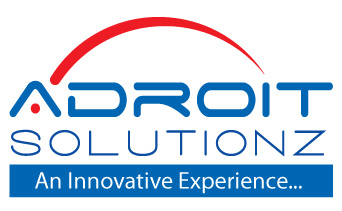Automation Industries
Increase Quality and Flexibility in Your Manufacturing Process

The future of Industry 4.0
Why Automate?
- Reduce Downtime
- Improve Quality
- Increase Productivity
- Enhance Safety
- Reduce Energy Cost
Automation
Adroit Solutionz has been achieved Automation Industry by various means including mechanical, hydraulic, electrical, electronic and computers, usually in combination.
Commonly Automation explains Computers can perform both sequential control and feedback control, and typically a single computer will do both in an industrial application. Programmable logic controllers (PLCs) are a type of special purpose microprocessor that replaced many hardware components such as timers and drum sequencers used in relay logic type systems
General purpose process control computers have increasingly replaced stand alone controllers, with a single computer able to perform the operations of hundreds of controllers. Process control computers can process data from a network of PLCs, instruments and controllers in order to implement typical (such as PID) control of many individual variables or, in some cases, to implement complex control algorithms using multiple inputs and mathematical manipulations. They can also analyze data and create real time graphical displays for operators and run reports for operators, engineers and management.
Advantages of Automation in Industry 4.0
- Cost efficiency: Reduces labour costs, automating portions of processes that do not require human judgment to leverage human creativity in obtaining new skills and activities where required. In addition, Virtual and/or Augmented reality technologies facilitate learning processes and improve productive organisation models.
- Competitive advantages: tandardisation and automatic redesign of procedures, making them constant and accurate, being able to operate 24/7. As a result, increased productivity, capacity and process quality, minimising inaccuracies and the cost of downtime.
- Time reduction: Reduced information processing times. The platforms with which automation works have a large capacity for the storage and management of data derived from processes.
- Utmost safety: The production line can assign machines and/or robots to hazardous tasks that pose a high risk to staff. In addition, advanced comprehensive security controls can be implemented for equipment, components, people, and systems. Cybersecurity is one of the essential technologies to safeguard companies’ privacy.
- Improved control: These types of processes are monitored and recorded, which generates ‘Big Data’; valuable information to identify patterns, improve processes, and implement changes to prevent future events. In addition, process optimisation opens the door to ‘insourcing’. This infrastructure centralisation improves data quality and consistency and leads to analytical improvements.
Disadvantages of Automation in Industry 4.0
- Investment and Infrastructure: Adapting the existing infrastructure to the new one can be a big challenge for companies, who will have to invest large sums of money and in many cases get access to financing in order to acquire the necessary infrastructure and decide which solutions will be the most profitable.
- Strategic Plan: The transition not only depends on investment in machinery and hardware, but requires time, a change of mind set, an intelligent analysis and a detailed strategy that maximises implementation and capitalises on the investment.
- Human factor: Smart devices are no longer working tools but have become an intelligent workforce, so millions of jobs are predicted to be lost as a result of automation processes. Society and large enterprises should therefore encourage continuous training for workers to develop relevant digital skills that complement with this new type of industry.
